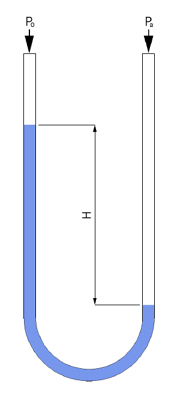
The difference in fluid height in a liquid column manometer is proportional to the pressure difference. h=\frac{P_a-P_o}{g \rho}
About[]
A manometer is an instrument that uses a column of liquid to measure pressure or vacuum.
Units[]
The SI unit for pressure is the pascal (Pa), equal to one newton per square metre (N·m−2 or kg·m−1·s−2). This special name for the unit was added in 1971; before that, pressure in SI was expressed in units such as N·m−2. When indicated, the zero reference is stated in parenthesis following the unit, for example 101 kPa (abs). The pound per square inch (psi) is still in widespread use in the US and Canada, for measuring, for instance, tire pressure. A letter is often appended to the psi unit to indicate the measurement's zero reference; psia for absolute, psig for gauge, psid for differential, although this practice is discouraged by the NIST[1].
Because pressure was once commonly measured by its ability to displace a column of liquid in a manometer, pressures are often expressed as a depth of a particular fluid (e.g., inches of water). Manometric measurement is the subject of pressure head calculations. The most common choices for a manometer's fluid are mercury (Hg) and water; water is nontoxic and readily available, while mercury's density allows for a shorter column (and so a smaller manometer) to measure a given pressure. The abbreviation "W.C." or the words "water column" are often printed on gauges and measurements that use water for the manometer.
Fluid density and local gravity can vary from one reading to another depending on local factors, so the height of a fluid column does not define pressure precisely. So measurements in "millimetres of mercury" or "inches of mercury" can be converted to SI units as long as attention is paid to the local factors of fluid density and gravity. Temperature fluctuations change the value of fluid density, while location can affect gravity.
U-shaped column[]
Pressure is defined as a force per unit area and the most accurate way to measure low pressure is to balance a column of liquid of known weight against itself. Next, measure the height of the balanced liquid column. The units of measure commonly used for infusion pump measurement is inches of mercury (in. Hg), using mercury as the fluid or inches of water (in. w.c.), using water or oil as the fluid.

Fig. 2-2. When positive pressure is applied to one leg, the liquid is forced down in that leg and up in the other. The difference in height, "h," which is the sum of the readings above and below zero, indicates the pressure.}
Fig. 2-1. In its simplest form the manometer is a U-tube about half filled with liquid. With both ends of the tube open, the liquid is at the same height in each leg.
Fig. 2-2. Currently, P1 to P1 is balanced. When positive pressure is applied to one leg (P1), the liquid is forced down in that leg (P1) and up in the other (P2). The difference in height, "h," which is the sum of the readings above and below zero, indicates the pressure.
Fig. 2-3. When a vacuum is applied to one leg, the liquid rises in that leg and falls in the other. The difference in height, "h," which is the sum of the readings above and below zero, indicates the amount of vacuum.
Instruments employing this principle are called manometers. The simplest form is the basic and well-known U-tube manometer. (Fig. 2-1). This device indicates the difference between two pressures (differential pressure), or between a single pressure and atmosphere (gage pressure), when one side is open to atmosphere. If a U-tube is filled to the half way point with water and air pressure is exerted on one of the columns, the fluid will be displaced. Thus one leg of water column will rise and the other falls. The difference in height "h" which is the sum of the readings above and below the half way point, indicates the pressure in inches of water column.
Terms[]
Terms: Pressure is "P" Force is "F" Mass is "m" Gravity acceleration on an object is "g" and g = 9.80665 m/s^2
Area is "A" Density is "p" and density of water (Pw) = 1000 kg/m^3 Volume is "V" Height is "h"
Manometer problem[]
Problem: Lets say that our manometer pressure has a height of 1 meter. Normal g = 9.80665 m/s^2 and p = 1000 kg/m^3. Solve for P.
Answer: P = 1m x 1000 kg/m^3 x 9.80665 m/s^2 is 9810 kg/m^s2.
and 1 newton (N) = (kg x m) / s^2
therefore, 9810 kg/m^s2 x N/ (kg x m / s^2) is 9810 N/m^2
and 1 Pascal (Pa) = N / m^2
therefore, 9810 N/m^2 x 1000 kPa is 9.81kPa
1. 0.1333 kPa = 1 mmHg 2. So, 9.81kPa divided by 1 mmhg equals 73.59mmhg
Final answer is 73.59 mmhg
Conversion[]
Convert mmhg to psi 1 mmhg = .01934 therefore, 73.59 x .01934 = 1.4229934835489 psi
Convert meter to inch 1 meter (m) = 39.37 inch (in)
References[]
- ↑ National Institute of Standards and Technology (NIST). "NIST GUIDE TO THE SI." July 2, 2009. http://physics.nist.gov/Pubs/SP811/sec07.html#7.4
Links[]
Convert kPa to mmhg: http://www.dwyer-inst.com/Products/ManometerIntroduction.cfm